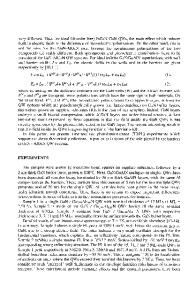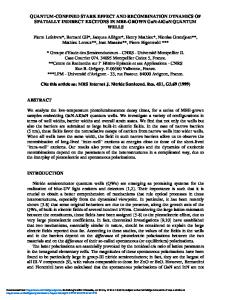Condensation of indirect excitons
- PDF / 2,957,965 Bytes
- 7 Pages / 585 x 783 pts Page_size
- 28 Downloads / 388 Views
troduction An exciton is a bound pair of an electron and a hole. At low densities, n > ξclassical is a direct measurement of BEC. In earlier studies, evidence for spontaneous coherence was obtained for IXs in CQWs7 and for IXs in quantum Hall bilayers.8,9 The onset of spontaneous coherence was evidenced by a strong enhancement of the rates of IX radiative recombination7 and electron tunneling,8 respectively. Direct measurements of spontaneous coherence are performed in interferometric experiments. Excitons transform to photons, which inherit their coherence, therefore, exciton coherence can be measured by probing coherence of their light
L.V. Butov, University of California, San Diego, USA; [email protected] doi:10.1557/mrs.2020.123
380
• VOLUME 45 • MAY 2020 Lund • mrs.org/bulletin © 2020 Materials Downloaded MRS fromBULLETIN https://www.cambridge.org/core. University Libraries, on 16 May 2020 at 15:25:18, subject to the Cambridge Core terms of use, available at https://www.cambridge.org/core/terms. https://doi.org/10.1557/mrs.2020.123
Research Society
Condensation of indirect excitons
Sidebar: Glossary Commensurability effect: The commensurability effect of an exciton density wave is the suppression of fluctuations of the exciton density wave when the number of its wavelengths on a confined wave segment is an integer. Dyakonov–Perel spin relaxation: Spin relaxation is the disappearance of nonequilibrium spin polarization. In general, spin relaxation is caused by fluctuating magnetic fields. The Dyakonov–Perel mechanism of spin relaxation is related to effective magnetic fields originating from the spin–orbit interaction in noncentrosymmetric materials. The effective magnetic field depends on the momentum and changes in time due to particle scattering. These field fluctuations cause the spin relaxation. The Dyakonov– Perel mechanism refers to the case when the scattering time is small in comparison to the inverse spin precession frequency. Electron–hole droplets: A real-space condensate of photoexcited electrons and holes into droplets of a metallic Fermi liquid of electrons and holes, the so-called electron– hole liquid, characterized by a definite equilibrium density of electron–hole pairs.
emission. An enhancement of the IX coherence length at low temperatures was first measured in interferometric experiments in a study reported in Reference 10. These experiments used the single-pinhole interferometric technique, which does not measure g1(δx), and the derivation of ξ was based on a mathematical analysis of the data.10,11 The direct measurement of spontaneous coherence (i.e., BEC) in a gas of IXs was performed in another study.12 In this work, the pattern of g1(δx) is measured by shift interferometry. The emission images produced by each of the two arms of the
Exciton density wave: An exciton state, dubbed the macroscopically ordered exciton state (MOES), which exhibits approximately periodic spatial modulation of the exciton density. First-order coherence function: The correlation of two electric
Data Loading...











